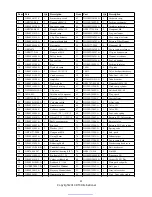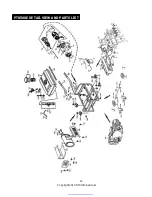
STARTING THE ENGINE
1.
Follow the guidelines on page 10
(Grounding the Generator).
2.
(located on top of
gas tank) for
adequate amount of
fuel for task. Inspect
tank for leaks. If the
tank is even seeping
a small amount of gas discontinue use until repaired.
Wipe up all spilled gas before starting engine. If gas
spills down in engine area, allow adequate time
gasoline to evaporation.
3.
The valve is located near the pull
start chord.
4.
Unplug any device or feed from the control
panel. Switch the circuit breaker to OFF.
5.
When
engine fires, you can adjust
the choke for running.
First, be sure that your generator is properly
grounded.
Check fuel gage
Next turn the fuel valve to the ON
position.
Make sure there are no electrical
devices pulling power from the
generator.
Move the choke to the
CLOSED position.
6.
When engine fires, you can adjust
the choke for running.
7.
8. When using the recoil start,
pull the cord slowly until
you feel tension or
resistance, then pull the
cord quickly to start the
generator.
once engine starts;
to get the longest life from your recoil start, treat cord
gingerly and refrain from allowing it to snap back into
place. You may need to repeat this step a few times to
initiate engine start. (If you still cannot start your
generator, please see the Troubleshooting Guide on
page 25).
Move the choke to the
CLOSED position.
Move the engine switch to the ON or START
position.
Note: Do not release cord
quickly
Allow the engine to run for 1-2 minutes and then
move the choke lever half way between OPEN and
CLOSED. Wait 20 seconds and move the choke
lever to the OPEN position.
1. Check and double check your electrical devices to
ensure that they are OFF.
2.
Refer to the chart (Figure E) for average wattage
reported from devices you may encounter. Most
electrical devices will have the wattage requirements
imprinted somewhere on the appliance. If the
requirements are reported in volts and amps you may
calculate the watts by this formula.
Be sure that the total running wattage of your
appliances does not exceed the running wattage of
your generator.
It is better
to combine totals that are less than the running rated
wattage than to risk overload.
Before connecting electrical devices to your
generator you must calculate the wattage draw the
devices will pull. Your electrical devices must not
add up to more than the running wattage.
NOTE: The generator is designed to run at
maximum surge for a short period of time. That
will allow a motor to start up without stalling the
generator. Some appliances require short bursts
of surge wattage to start or run their motors.
Watts= Amps x Volts
DO NOT COMBINE RUNNING
WATTAGES THAT TOTAL THE SURGE WATTAGE
OF YOUR GENERATOR AND ATTEMPT TO
OPERATE.
If you find that your combined load will exceed the
rating of your generator, you may need to group one
or more devices on a separate Generator.
Tornado
:
Running Wattage: 5500
Surge Wattage: 6500
PT6500E
USING THE GENERATOR (AC)
6
Copyright 2010 DTX International
9. T
h
In case the battery is dead or
weak, the engine can be started
with the pull start chord. Follow
the same procedure as above.
urn t e key to the right until the
electric start motor engages.
When the engine fires let the
key return to the run position.
Allow engine to warm up before pulling current
from the generator.
11
Gale Force PT8500E:
Running Wattage: 7000
Surge Wattage: 8500











































